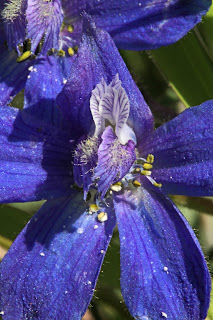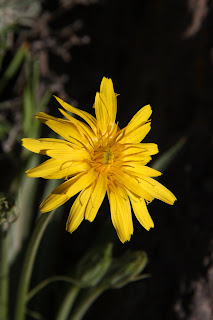The first week in April was spring vacation and an opportunity to visit our handicapped son. Since the weather was beautiful it was also an opportunity to do some hiking, the first real hike of the year. After some research on the internet we decided to follow the suggestion of a friend and hike in the Quincy Wildlife Recreation Area near the Columbia River.
We left home early in the morning and were on the trail before 8:00 am. There was only one other car at the trailhead and we saw no one else until later in the day when we stopped for lunch. We hiked two coulees to several different lakes, including both Dusty Lake and Ancient Lakes and did in all a total of six to seven miles, but not difficult hiking.
In eastern Washington the word “coulee” is used to describe a broad valley formed by glacial drainage. The two coulees we hiked have high steep walls of volcanic material and the geologic formations are one of the high points of the hike. Both coulees open to the west where the land very quickly drops down to the Columbia River.
We hiked across the open end of the first coulee, around the end of the mesa that separates it from the second and into the second. A waterfall was visible in the morning light on the northern wall of the first coulee, a waterfall we would visit at the end of the day’s hiking. The area was already dry and dusty with sagebrush the main plant.
Hiking down the second coulee we found a few wildflowers blooming including the Slender Woodland Stars and Woolley-pod Locoweed pictured below. At the far end of the coulee we came finally to Dusty Lake. We wondered about the white mineral deposits all around the lake but have been unable to identify them, though they must be from the water of the lakes.
We clambered along the rock fall at the north end of the lake and eventually found a trail that took us up the loose rock to a narrow path along the side of the mesa to a place where we could cross the mesa and descend to the first coulee and the three lakes there known as Ancient Lakes. The trail looked impossible from below but was not that bad.
Crossing the mesa and descending on the other side we began to find more wildflowers, Few-flowered Shooting Stars, a few Arrow-leaf Balsamroots, and Menzies Larkspurs. We stopped to take photos before descending to the lakes below and wandering among them though it is difficult to circle the lakes because of the steep sides of the mesas and the loose rock.
Especially around the lakes several shrubs were blooming which we identified as the Western Serviceberry and the Squaw Currant. A few of the Arrow-leaf Balsamroots were also starting to bloom, a sign, I'm sure that we are going to have a very early spring this year. We found one plant of False Agoseris in bloom and lots of Bugloss Fiddleneck which my wife photographed.
Squaw Currant
False Agoseris and Arrowleaf Balsamroot
Bugloss Fiddleneck
Near the first lake we found a Mourning Cloak butterfly laying her eggs on a twig. We watched for quite a while and took all the pictures we wanted before she finished and flew away. That certainly was one of the high points of the hike. My wife found her first, as is often the case, and it was only as we took pictures that we noticed the egg-laying.
Mourning Cloak
We could already see a waterfall at the northeast end of the second lake and following the trail and scrambling over loose rock we made our way there. We rested there, had our lunch and spent time taking time exposures of the falls and watching a group of young people who had followed a steeper trail down and were diving from the rocks.
After lunch we circled the rest of the way around the second lake and began the hike out of the coulee, passing the third lake on the way and taking pictures as we found them. We found more wildflowers near the lakes including some of the Lomatiums or Desert Parsleys, Gray's Desert Parsley, Gorman's Lomatium and the Fernleaf Lomatium.
Gray's Desert Parsley
Fernleaf Lomatium or Chocolate Tips
Gorman's Lomatium or Salt and Pepper
Not far from the end of the coulee and the end of our hike we passed the waterfall we had seen earlier in the morning and stopped for more pictures, this time from a closer vantage point. We also found nearby a wildflower we had been looking for, Yellow Bells, Fritillaria pudica, and took pictures, before returning to our car and making our way towards Spokane.
Yellow Bells
Blue Mustard
Near the trailhead and on the road we found a tom turkey and two hens, the tom strutting his stuff for the hens. They seemed more interested in foraging than in him and he finally gave it up and ran past the car and down the road. We watched the three of them for quite some time, however, and thought them another high point of the day’s activities.
Yellow Bells - Fritillaria pudica
Fernleaf Lomatium, Chocolate Tips - Lomatium dissectum
Gray’s Desert Parsley - Lomatium grayi
Upland Larkspur - Delphinium nuttallianum
Slender Woodland Star - Lithophragma tenellum
Blue Mustard - Chorispora tenella
Woolly-pod Locoweed, Pursh’s Woolly Pod - Astragalus purshii
Few-flowered Shooting Star - Dodecatheon pulchellum
Gorman’s Lomatium, Salt and Pepper - Lomatium gormanii
False Agoseris - Nothocalais troximoides
Bugloss Fiddleneck - Amsinckia lycopsoides
Arrowleaf Balsamroot - Balsamorhiza sagittata
Western Serviceberry - Amelanchier alnifolia
Squaw Currant - Ribes cereum





















































































4 comments:
Ron I loved this place when I visited and i am envious of your photos. The quality of the light is fantastic and lends itself to wonderful definition on the photos. That hanging waterfall on the north ( left hand ) wall was no where near that full when I visited. When I was there is was more like the wall was wet and trickling.
The Mourning Cloak is a fine prize for photo. I saw plenty on my visit to Reecer Creek.
This place captivated us, too. The air and light have a special quality out there and the beauty of the area is hard to describe, though of a completely different kind than on the west side of the mountains.
What a neat place! Filled with so many interesting rock formations and plants. Great series of shots =)
~Fizzie~
Thanks, Fizzie. Eastern Washington is like a different country compared to the area we live in which is always lush and green. It has a wonderful beauty of its own and it is easy to fall in love with the wide open spaces, the blue skies and the wonderful flora and fauna of the area.
Post a Comment